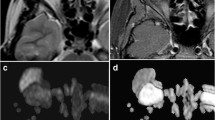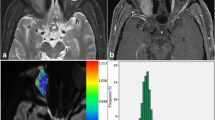Abstract
Purpose
To systematically evaluate the utility of different magnetic resonance imaging (MRI) features, including quantitative diffusion-weighted imaging, in differentiating benign from malignant pediatric orbital masses.
Methods
The use of MRI in 40 pediatric patients with orbital masses was retrospectively reviewed. Multiple subjective and objective MRI parameters, including lesion mean apparent diffusion coefficient (ADC) values and lesion-to-thalamus ADC ratio were recorded. Bivariate analysis was done to identify parameters that were significantly different between benign and malignant subgroups. Receiver operating curves were used to establish optimal cut-off values for lesion mean ADC and lesion-to-thalamus ADC ratio for predicting benign versus malignant lesions.
Results
Lesion mean ADC, lesion-to-thalamus ADC ratio and extent of contrast enhancement showed statistically significant differences between the two subgroups. For distinguishing benign from malignant lesions, a lesion mean ADC cut-off value of 1.14 × 10−3 mm2/s provided a sensitivity of 84% and specificity of 100%, while an ADC ratio of 1.4 provided a sensitivity of 81% and specificity of 89%.
Conclusion
Quantitative diffusion-weighted imaging can be a useful adjunct in characterizing pediatric orbital masses by MRI, and thus help in clinical decision making.








Similar content being viewed by others
References
Chung EM, Smirniotopoulos JG, Specht CS, Schroeder JW, Cube R. From the archives of the AFIP: pediatric orbit tumors and tumorlike lesions: nonosseous lesions of the extraocular orbit. Radiographics. 2007;27:1777–99.
Gorospe L, Royo A, Berrocal T, García-Raya P, Moreno P, Abelairas J. Imaging of orbital disorders in pediatric patients. Eur Radiol. 2003;13:2012–26.
Khan SN, Sepahdari AR. Orbital masses: CT and MRI of common vascular lesions, benign tumors, and malignancies. Saudi J Ophthalmol. 2012;26:373–83.
Burns NS, Iyer RS, Robinson AJ, Chapman T. Diagnostic imaging of fetal and pediatric 12 orbital abnormalities. AJR Am J Roentgenol. 2013;201:W797–808.
Rao AA, Naheedy JH, Chen JY, Robbins SL, Ramkumar HL. A clinical update and radiologic review of pediatric orbital and ocular tumors. J Oncol. 2013;2013:975908.
Sepahdari AR, Kapur R, Aakalu VK, Villablanca JP, Mafee MF. Diffusion-weighted imaging of malignant ocular masses: initial results and directions for further study. AJNR Am J Neuroradiol. 2012;33:314–9.
Sepahdari AR, Aakalu VK, Setabutr P, Shiehmorteza M, Naheedy JH, Mafee MF. Indeterminate orbital masses: restricted diffusion at MR imaging with echo-planar diffusion-weighted imaging predicts malignancy. Radiology. 2010;256:554–64.
Razek AA, Elkhamary S, Mousa A. Differentiation between benign and malignant orbital tumors at 3‑T diffusion MR-imaging. Neuroradiology. 2011;53:517–22.
Fatima Z, Ichikawa T, Ishigame K, Motosugi U, Waqar AB, Hori M, Iijima H, Araki T. Orbital masses: the usefulness of diffusion-weighted imaging in lesion categorization. Clin Neuroradiol. 2014;24:129–34.
Morriss MC, Zimmerman RA, Bilaniuk LT, Hunter JV, Haselgrove JC. Changes in brain water diffusion during childhood. Neuroradiology. 1999;41:929–34.
Mukherjee P, Miller JH, Shimony JS, Conturo TE, Lee BC, Almli CR, McKinstry RC. Normal brain maturation during childhood: developmental trends characterizedwith diffusion-tensorMR imaging. Radiology. 2001;221:349–58.
Forbes KP, Pipe JG, Bird CR. Changes in brain water diffusion during the 1st year of life. Radiology. 2002;222:405–9.
Bilgili Y, Unal B. Effect of region of interest on interobserver variance in apparent diffusion coefficient measures. AJNR Am J Neuroradiol. 2004;25:108–11.
Viswanathan S, George S, Ramadwar M, Shet T, Arora B, Laskar S, Qureshi S, Medhi S, Muckaden MA, Kurkure PA, Kane SV, Banavali S. Extraconal orbital tumors in children—a spectrum. Virchows Arch. 2009;454:703–13.
Shields JA, Shields CL, Scartozzi R. Survey of 1264 patients with orbital tumors and simulating lesions: The 2002 Montgomery Lecture, part 1. Ophthalmology. 2004;111:997–1008.
Smoker WR, Gentry LR, Yee NK, Reede DL, Nerad JA. Vascular lesions of the orbit: more than meets the eye. Radiographics. 2008;28:185–204.
Cha S. Update on brain tumor imaging: from anatomy to physiology. AJNR Am J Neuroradiol. 2006;27:475–87.
Koontz NA, Wiggins RH 3rd. Differentiation of benign and malignant head and neck lesions with diffusion tensor imaging and DWI. AJR Am J Roentgenol. 2017;208:1110–5.
Wang J, Takashima S, Takayama F, Kawakami S, Saito A, Matsushita T, Momose M, Ishiyama T. Head and neck lesions: characterization with diffusion-weighted echo-planar MR imaging. Radiology. 2001;220:621–30.
Srinivasan A, Mohan S, Mukherji S. Biologic imaging of head and neck cancer: the present and the future. AJNR Am J Neuroradiol. 2012;33:586–94.
Sepahdari AR, Politi LS, Aakalu VK, Kim HJ, Razek AA. Diffusion-weighted imaging of orbital masses: multi-institutional data support a 2-ADC threshold model to categorize lesions as benign, malignant, or indeterminate. AJNR Am J Neuroradiol. 2014;35:170–5.
Politi LS, Forghani R, Godi C, Resti AG, Ponzoni M, Bianchi S, Iadanza A, Ambrosi A, Falini A, Ferreri AJ, Curtin HD, Scotti G. Ocular adnexal lymphoma: diffusion-weighted MR imaging for differential diagnosis and therapeutic monitoring. Radiology. 2010;256:565–74.
ElKhamary SM, Galindo-Ferreiro A, AlGhafri L, Khandekar R, Schellini SA. Characterization of diffuse orbital mass using Apparent diffusion coefficient in 3‑tesla MRI. Eur J Radiol Open. 2018;5:52-57.
Kralik SF, Haider KM, Lobo RR, Supakul N, Calloni SF, Soares BP. Orbital infantile hemangioma and rhabdomyosarcoma in children: differentiation using diffusion-weighted magnetic resonance imaging. J AAPOS. 2018;22:27–31.
Kodsi SR, Shetlar DJ, Campbell RJ, Garrity JA, Bartley GB. A review of 340 orbital tumors in children during a 60-yearperiod. Am J Ophthalmol. 1994;117:177–82.
Lope LA, Hutcheson KA, Khademian ZP. Magnetic resonance imaging in the analysis of pediatric orbital tumors: utility of diffusion-weighted imaging. J AAPOS. 2010;14:257–62.
Chenevert TL, Galbán CJ, Ivancevic MK, Rohrer SE, Londy FJ, Kwee TC, Meyer CR, Johnson TD, Rehemtulla A, Ross BD. Diffusion coefficient measurement using a temperature-controlled fluid for quality control in multicenter studies. J Magn Reson Imaging. 2011;34:983–7.
Kıvrak AS, Paksoy Y, Erol C, Koplay M, Özbek S, Kara F. Comparison of apparent diffusion coefficient values among different MRI platforms: a multicenter phantom study. Diagn Interv Radiol. 2012;19:433–7.
Author information
Authors and Affiliations
Corresponding author
Ethics declarations
Conflict of interest
A. Jaju, K. Rychlik and M.E. Ryan declare that they have no competing interests.
Ethical standards
All procedures performed in the studies involving human participants were in accordance with the ethical standards of the institutional and/or national research committee and with the 1964 Helsinki Declaration and its later amendments or comparable ethical standards. For this retrospective study, the informed consent requirement was waived by the Institutional Review Board. For images or other information within the manuscript which identify patients, consent was obtained from them and/or their legal guardians.
Rights and permissions
About this article
Cite this article
Jaju, A., Rychlik, K. & Ryan, M.E. MRI of Pediatric Orbital Masses: Role of Quantitative Diffusion-weighted Imaging in Differentiating Benign from Malignant Lesions. Clin Neuroradiol 30, 615–624 (2020). https://doi.org/10.1007/s00062-019-00790-4
Received:
Accepted:
Published:
Issue Date:
DOI: https://doi.org/10.1007/s00062-019-00790-4




